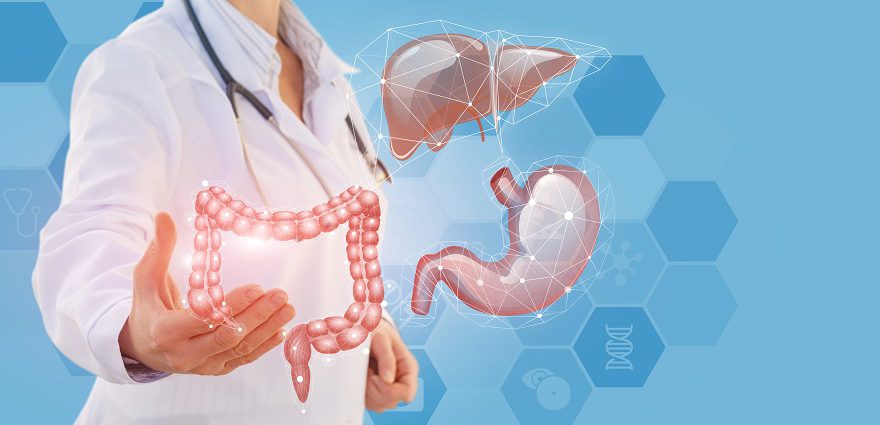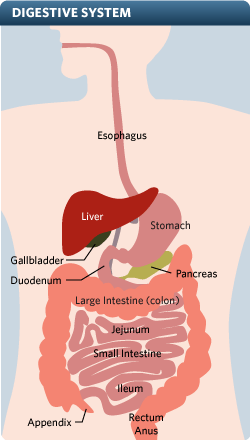Digestion 101 – Understanding the Basics

To understand fully the changes that your weight loss surgery will mean for your digestive process, it’s important to understand how digestion works before surgical alteration.
In essence, digestion is the process by which our body breaks down food so that it can be used for nourishment and energy. Food must be smaller to be absorbed into the bloodstream and carried to waiting cells throughout the body.
The Key Players of the Digestive Process
The digestive tract comprises the mouth, esophagus, stomach, small and large intestines (the colon), the rectum and the anus. These organs are lined by mucosae (mucous membranes). The mucosa in the stomach and small intestines contains tiny glands that produce juices to aid in digestion. The digestive tract also contains a layer of smooth muscle to help break down food and move it efficiently through the tract.
The liver and pancreas are also important in the digestive process. They both produce juices that reach the small intestine through ducts. The gall bladder, in turn, stores the digestive juice that is produced by the liver until it is needed.

Digestion at a Glance
The digestive process starts in the mouth, where food is chewed and swallowed. The swallowed food then travels into the esophagus, which connects the throat to the stomach. A ring-like muscle called the esophageal sphincter connects the esophagus to the stomach. This muscle basically acts as a door that closes the passage between the esophagus and the stomach. As food approaches this muscle, it opens and allows food to pass through to the stomach.
As you can imagine, the stomach plays a big role in digestion. For starters, it stores the swallowed food and liquid. A muscle in the upper part of the stomach relaxes so it is able to accept large volumes of food and liquid. Next, the lower part of the stomach mixes the food and liquid with digestive juices produced there. Finally, the stomach slowly empties its contents into the small intestine.
The contents are then absorbed into the intestinal walls and transported through the body. Certain materials are not used. Such waste products include undigested parts of food (fiber) and older cells that are shed from the mucosal lining. These waste materials are pushed into the colon, where they can be excreted as stool.
Digestion Interrupted
Weight loss surgery interferes with digestion to help bring about weight loss.
For example, gastric bypass surgery makes the stomach smaller and allows food to bypass part of the small intestine. (If you recall, the small intestine is where most of the nutrients and calories are absorbed.) The stomach is made smaller by creating a small pouch at the top of the stomach. The smaller stomach is then connected directly to the middle portion of the small intestine (jejunum), bypassing the rest of the stomach and the upper portion of the small intestine (duodenum). As a result, food travels directly into the lower part of the small intestine. Bypassing these sections restricts the amount of calories and nutrients that are absorbed into the body, resulting in weight loss.
Gastric banding also affects digestion. It involves placing a silicone band with an inflatable inner collar around the upper stomach to restrict food intake. This creates a small pouch and a narrow passage to the lower stomach that can hold only a small amount of food. The band also controls the stoma (stomach outlet) between the new upper pouch and the lower part of the stomach. This helps you feel full faster. In addition, the food moves more slowly between the upper and lower stomach during digestion. This helps you to eat less and lose weight.
About the Reviewer of This Article
Robynne K. Chutkan, MD, FASGE, is the founder and medical director of Digestive Center for Women, LLC, in Chevy Chase, Md. After earning her bachelor’s degree at Yale University, Dr. Chutkan received her medical degree from Columbia College of Physicians and Surgeons. She completed her internship and residency in internal medicine at Columbia and also served as chief resident. After completing her fellowship in gastroenterology at Mount Sinai Hospital in New York, she joined the faculty in the Gastroenterology Division at Georgetown Hospital in Washington D.C., where she is an assistant professor.
Sources:
National Digestive Diseases Information Clearinghouse website. Your Digestive System and How It Works.


